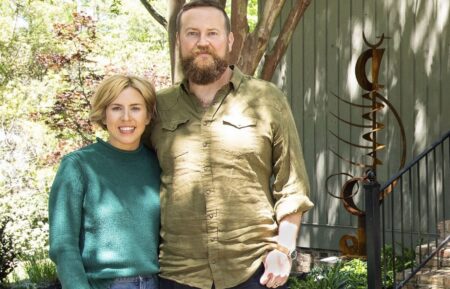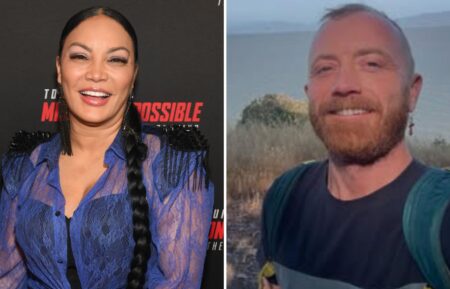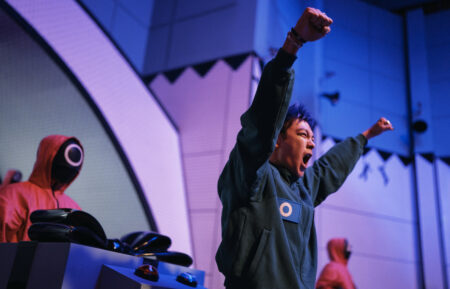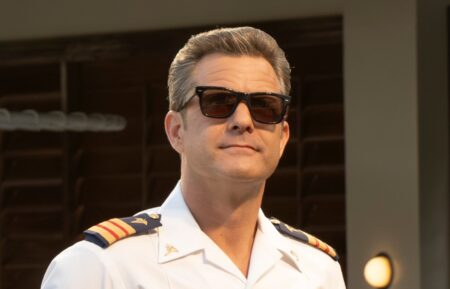Jane the Virgin’s Bright, Sunny Style Is a Welcome Visual Treat
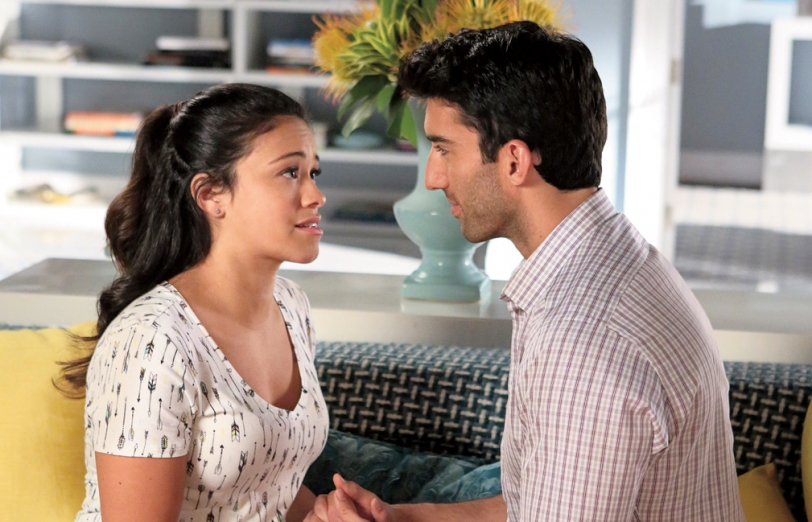
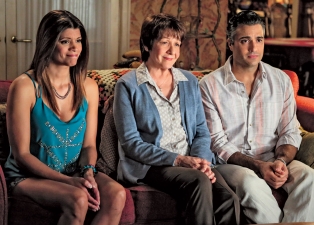
It’s a sunny morning in Sherman Oaks, California, and Jane the Virgin showrunner Jennie Urman has come into the writers’ offices during the show’s winter hiatus. She’s loaded down with blueprints and wardrobe boards, the better to illustrate exactly what she and the Jane crew are trying to say with their set design and color scheme. “Our show is a little brighter,” Urman says, opening a tone book. “Both visually and in spirit.”
That’s a bit of an understatement. In a TV landscape chockablock with brooding dramas drained of all color, Jane, with its playful tone and rich riot of a palette, just pops. (It’s also one of those hour-long series that straddle the comedy-drama line, but the Academy of Television Arts and Sciences now counts all hourlong shows as dramas, so we’ll play by their rules with the caveat that, yes, it is very, very funny.)
In the late ’90s, cable networks, and then their broadcast counterparts in the mid-Aughts, decided that “prestige” meant “really, really dark.” Breaking Bad, set in the yellow-saturated Albuquerque desert, frequently cloaked itself in night shoots and blander wardrobe choices to create a counterpoint to the brilliant lapis lazuli dome of the daytime sky. The single-shot action sequence that earned true True Detective praise took place at night, mostly in close, dimly lit quarters. Even The Good Wife, a brilliant drama that refuses to take itself too seriously, is more muted, visually—as is appropriate for a show about a woman testing her own moral boundaries. Characters on these murky shows are constantly sunk in shadow, or, as Urman puts it, “There’ll be, like, one lamp on, which is the vocabulary for, ‘I’m alone and have a lot on my mind.'”
Not every hour-long show on TV has to be a sunny portrait of humanity, but having a show like Jane, which unabashedly believes in the inherent goodness of people, is nice. The show’s Miami setting (actually shot in Manhattan Beach, California) helps keep that steady warmth at the forefront of viewers’ minds, a contrast to the unrelenting iron grey of the myriad shows that shoot in soggy locales like Vancouver. Miami also provides a more eclectic tableau: “I feel like it’s such a mix of the sacred and profane,” Urman says. “There’s a real religious community, but there’s also all this excess.”
She’s set up a three-tiered world for Jane: The “worn, faded, but cozy” Miami in which Jane Villanueva (Gina Rodriguez)—the titular virgin—and her family live; the “big fantasy” of Jane’s baby’s father Rafael (Justin Baldoni), and his fancy hotel; and the telenovela starring Jane’s father Rogelio (Jaime Camil.)
FAMILY LIVING
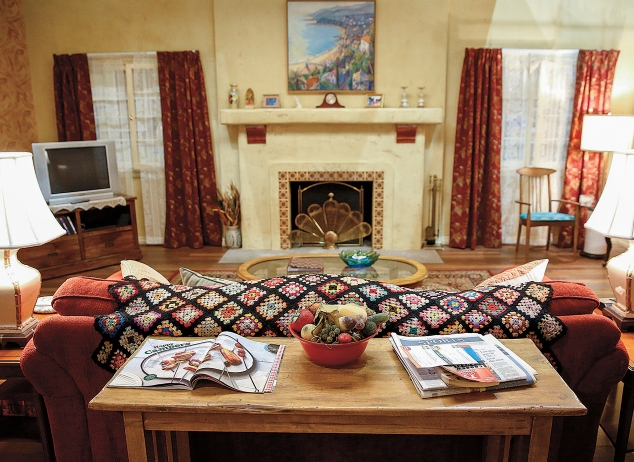
Jane, her mother Xiomara (Andrea Navedo), and grandmother Alba (Ivonne Coll) have always lived in the same house. “In the Villanueva house, it’s all tobaccos and ombres and deep reds—we wanted a vocabulary of warmth,” Urman says. “You wanted the feeling of three generations all living together.”
That feeling extends to electronics. Despite the Villanuevas’ love of telenovelas, Urman says, it wouldn’t make sense for the family to have a big flat-screen TV in their living room; it’s just not the kind of item the family would splurge on. So her design team found a “period” TV at one of Hollywood’s many prop houses. (Yes, the ’90s count as a “period” now.)
The worn blanket that adorns the back of the Villanuevas’ couch looks like one you’d pull out of your grandmother’s linen closet—which is exactly the point. “You imagine that Alba made it long ago,” Urman says. She grows more animated as she turns the pages and begins to talk about the family’s dynamics—the women fight and bicker, but that blood bond always wins out. “To me, that’s the real heart of the show,” she says.
HOTEL BLUES
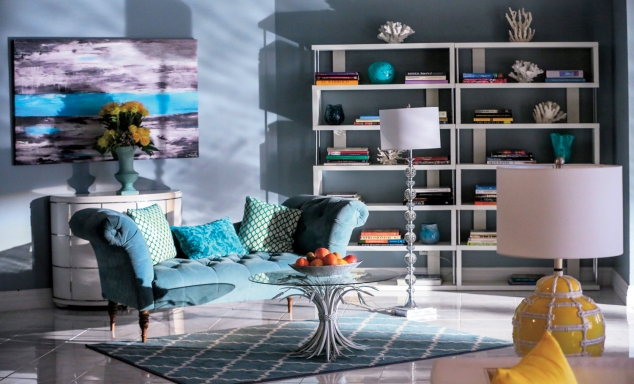
The hotel Rafael co-owns and calls home, the Marbella, is limited to bright blues (preferably turquoise), whites, and corals—with a splash of yellow in Rafael’s penthouse. “We wanted it to have a bit of a fairytale quality,” says Urman, “but with a lowercase f. Just a touch of fairydust.”
When it came time to create the hotel’s color scheme, Urman brought in a small turquoise vase from her house for inspiration, and promptly forgot to bring it home. The vase found its way onto Rafael’s shelf—until Urman noticed the familiar-looking piece and asked the set dressers to take it back to its rightful place.
The large abstract painting in Rafael’s penthouse is a custom piece of art German artist Ilonka Walter created just for the show. “I scoured the internet for a specific kind of high-end abstract painting—with turquoise!—and found her,” Urman says.
TELENOVELA LOOKS
The sphere of the telenovela, as befits its heightened reality, is the most saturated, the one that comes closest to that typical South Beach excess. Though Rogelio recently found himself killed off his beloved show, he’ll be starting a new role on another one starting tonight, so we won’t lose the lavender-infused fantasy. (Rogelio feels lavender is the most manly purple, naturally.)
“We try to keep them pretty distinct,” Urman says. “But if there’s a touch of lavender somewhere else, I’m not going to say, ‘NO!'”
While other shows fish bodies of murdered women (so many murdered women) out of creeks, or spend an episode building up to a nighttime shootout in an alleyway, Jane dispatches a guy by having him hurled from a balcony onto an ice sculpture of a marlin, his impaled body leaking some very eye-catching blood. (Before the horror can sink in, though, the show’s fantastically cheeky Latin Lover Narrator chimes in, remarking that, well, it wasn’t the worst party Jane had been to.) Urman laughs at the memory of the scene: “Even our murders are a little more upbeat!”
Jane the Virgin, Mondays, 9/8c, The CW
From TV Guide Magazine
How 'Countdown' Recruited Jensen Ackles to Go Full 'Die Hard'
Countdown boss Derek Haas talks creating the character around Ackles, and the cast teases the “Avengers”-like team of the crime thriller. Read the story now on TV Insider.





